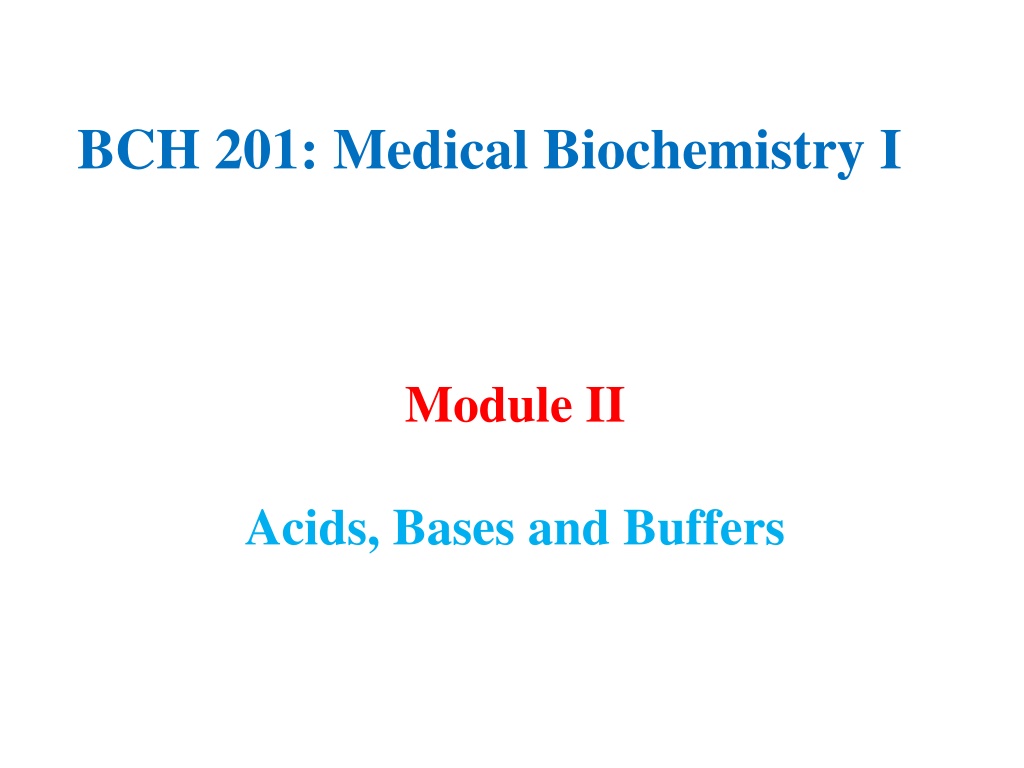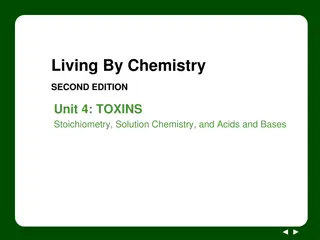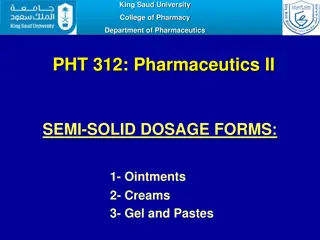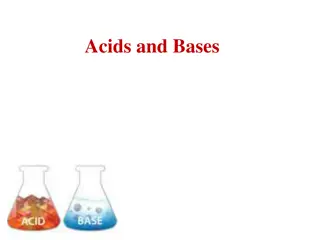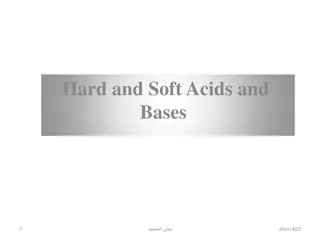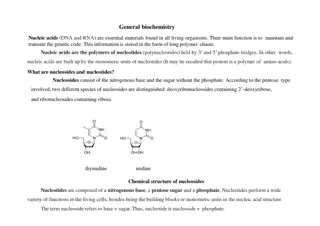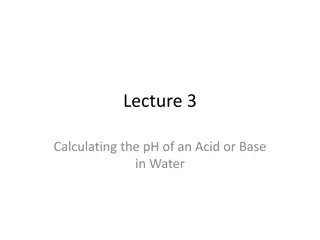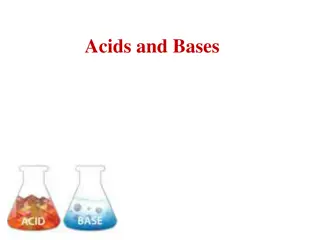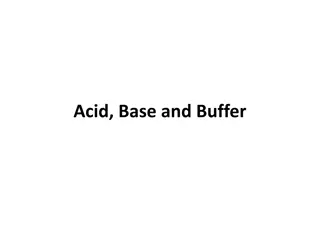Understanding Acids, Bases, and Buffers in Medical Biochemistry
Biologically important molecules, such as acids and bases, have significant roles in metabolism. Strong acids like hydrochloric acid ionize completely, while weak acids and bases play crucial regulatory roles. The Bronsted-Lowry theory defines acids as proton donors and bases as proton acceptors. Equilibrium constants like Ka quantify the tendency of acids to lose protons. Water ionizes slightly, forming hydrogen and hydroxide ions, with Kw representing the ion product. The pH scale measures hydrogen ion concentration logarithmically.
Download Presentation

Please find below an Image/Link to download the presentation.
The content on the website is provided AS IS for your information and personal use only. It may not be sold, licensed, or shared on other websites without obtaining consent from the author. Download presentation by click this link. If you encounter any issues during the download, it is possible that the publisher has removed the file from their server.
E N D
Presentation Transcript
BCH 201: Medical Biochemistry I Module II Acids, Bases and Buffers
Many biologically important molecules are acids or bases. Hydrochloric, sulfuric, and nitric acids, commonly called strong acids, are completely ionized in dilute aqueous solutions; the strong bases NaOH and KOH are also completely ionized. Of more interest to biochemists is the behaviour of weak acids and bases - those not completely ionized when dissolved in water. These are common in biological systems and play important roles in metabolism and its regulation.
Bronsted Lowry defined an acid as a proton donor and a base as a proton acceptor. Hydrochloric acid (HCl) and sulfuric acid (H2SO4) are strong acids because they dissociate totally: HCl H+ + Cl- H2SO4 2H+ + SO42- OH- ion is a base because it accepts a proton, shifting the equilibrium: OH- + H+ H2O Lactic acid is a weak acid A proton donor and its corresponding proton acceptor make up a conjugate acid-base pair
Acetic acid (CH3COOH), a proton donor, and the acetate anion (CH3COO-), the corresponding proton acceptor, constitute a conjugate acid-base pair, related by the reversible reaction: CH3COOH H+ + CH3COO- Each acid has a characteristic tendency to lose its proton in an aqueous solution. The stronger the acid is, the greater its tendency to lose its proton. The tendency of any acid (HA) to lose a proton and form its conjugate base (A-) is defined by the equilibrium constant (Keq) for the reversible reaction. Equilibrium constants for ionization reactions are usually called ionization or dissociation constants, often designated Ka
HA = A-+ H+ [H+][A-] [HA] Ka Keq= Ionization of water, weak acids and bases Pure water ionizes slightly, forming equal numbers of hydrogen ions (hydrozonium ions, H3O+) and hydroxide ions (OH-). H2O OH-+ H+ Keq= [H+][OH-] [H2O] Keq= 1.8 10-16 M The value for Keq, determined by electrical-conductivity measurements of pure water, is 1.8 10-16 M at 25 0C. Substituting this value for Keq gives the value of the ion product of water (Kw):
Kw = [H+][OH-] = (55.5 M)(1.8 10 -16 M) = 1.0 10-14 M2 Thus the product [H+][OH-] in aqueous solutions at 25 0C always equals 1.0 10-14 M2. When there are exactly equal concentrations of H+ and OH-, as in pure water, the solution is said to be at neutral pH. From which the ion product of water, Kw, is derived. At 250C, Kw = [H+][OH-] = (55.5 M)(Keq) = 10-14 M2 The pH The pH of an aqueous solution reflects, on a logarithmic scale, the concentration of hydrogen ions: pH = - log [H+] = 1 log [H+]
For hydrogen ion concentration of 1.0 10-7 M, the pH can be calculated as follows: pH = - log [H+] = 1 = 1 log [H+] 1.0 10-7 M = log1 + log 10-7 = 0 + 7 = 7 The expression pOH is sometimes used to describe the basicity, or OH-concentration, of a solution; pOH = -log [OH-], which is analogous to the expression for pH Note that in all cases, pH + pOH = 14.
Table 1. pH of Some Biological Fluids Fluid pH Blood plasma Interstitial fluid Cytosol (liver) Lysosomal matrix Gastric juice Pancreatic juice Human milk Saliva Urine 7.4 7.4 6.9 < 5.0 1.5 3.0 7.8-8.0 7.4 6.4-7.0 5.0-8.0
The greater the acidity of a solution the lower its pH. Weak acids partially ionize to release a hydrogen ion, thus lowering the pH of the aqueous solution. Weak bases accept a hydrogen ion, increasing the pH. The extent of these processes is characteristic of each particular weak acid or base and is expressed as a dissociation constant, Ka: Keq = [H+] [A-] = Ka [HA]
The pKa The pKa expresses, on a logarithmic scale, the relative strength of a weak acid or base: pKa = - log [Ka] = 1 log [Ka] The stronger the acid the lower its pKa; the stronger the base, the higher its pKa. The pKa can be determined experimentally; it is the pH at the midpoint of the titration curve for the acid or base
Henderson-Hasselbalch (HH) Equation Defines the Relationship Between pH and Concentrations of Conjugate Acid and Base Conjugate acid conjugate base + H+ K eq = [H+][conjugate base] [conjugate acid] (1) Rearranging eqn. 1 by dividing through by both [H+] and K eq leads to: 1 = 1 [conjugate base] [H+] K eq [conjugate acid] Taking the logarithm of both sides gives: Log 1 = log 1 + log [conjugate base] [conjugate acid] (2) K eq [H+]
Since pH = log 1/[H+] and pK = log 1/Keq, eqn 2 becomes: pH = pK + log [conjugate base] [conjugate acid] (3) Equation 3, developed by Henderson and Hasselbalch, is a convenient way of viewing the relationship between pH of a solution and relative amounts of conjugate base and acid present. Analysis of Eq. 3 demonstrates that when the ratio of (base)/(acid) is 1: 1, pH equals the pK of the acid because log 1 = 0
Worked Examples 1. Calculate the ratio of HPO42-/H2PO4- (pK = 6.7) at pH 5.7, 6.7, and 8.7. Solution: pH = pK + log [HPO42-] [H2PO4-] 5.7 = 6.7 + log of ratio; rearranging 5.7 6.7 = -1 = log of ratio The antilog of -1 = 0.1 or 1/10. Thus HPO42-/H2PO4- = 1/10 at pH 5.7. Using the same procedure, the ratio at pH 6.7 = 1/1 and at pH 8.7 = 100/1.
2. the concentration of CO2 in blood (pK for HCO3-/CO2 = 6.1)? If the pH of blood is 7.1 and the HCO3- concentration is 8 mM, what is Solution: pH = pK + log HCO3- CO2 7.1 = 6.1 + log 8mM/(CO2); rearranging 7.1 6.1 = 1 = log 8 mM/ (CO2). The antilog of 1 = 10. Thus, 10 = 8mM/(CO2), or (CO2) = 8 mM/10 = 0.8 mM.
3. At a normal blood pH of 7.4, the sum of [HCO3-] + (CO2) = 25.2 mM. What is the concentration of HCO3- and CO2 (pK for HCO3-/CO2 = 6.1)? Solution: pH = pK + log HCO3- CO2 7.4 = 6.1 + log (HCO3-)/(CO2); rearranging 7.4 6.1 = 1.3 = log (HCO3-)/(CO2). The antilog of 1.3 is 20. Thus (HCO3-)/(CO2) = 20. Given (HCO3-) + (CO2) = 25.2, solve these two equations for (CO2) by rearranging the first equation; (HCO3-) = 20 (CO2): Substituting in the second equation, 20 (CO2) + (CO2) = 25.2 CO2 = 1.2 mM or Then substituting for CO2, 1.2 + (HCO3-) = 25.2, and solving, (HCO3-) = 24 mM.
Buffering is Important to Control pH Buffering capacity is defined as the ability of a solution to resist a change in pH when an acid or base is added. If weak acid were not present, the pH would be very high with only a small amount of OH- because there would be no source of H+ to neutralize the OH-. The best buffering range for a conjugate pair is in the pH range near the pK of the weak acid. Starting from a pH one unit below to a pH one unit above pK . The maximum buffering range for a conjugate pair is considered to be between 1 pH unit above and below the pK .
Lactic acid with pK = 3.86 is an effective buffer in the range of pH 3 to 5 but has no buffering capacity at pH = 7.0. The HPO42-/H2PO4- pair with pK = 6.7, however, is an effective buffer at pH = 7.0. Thus at the pH of the cell s cytosol (7.0), the lactate-lactic acid pair is not an effective buffer but the phosphate system is. Buffering capacity also depends on the concentrations of conjugate acid and base. The higher the concentration of conjugate base, the more added H+ with which it can react. The more conjugate acid the more added OH- can be neutralized by the dissociation of the acid.
A case in point is blood plasma at pH 7.4 for HPO42-/H2PO4- , the pK of 6.7 would suggest that this conjugate pair would be an effective buffer; the concentration of the phosphate pair, however, is low compared to that of the HCO3-/CO2 system with a pK of 6.1, which is present at a 20-fold higher concentration and accounts for most of the buffering capacity. In considering the buffering capacity, both the pK and the concentrations of the conjugate pair must be taken into account. Most organic acids are relatively unimportant as buffers in cellular fluids because their pK values are more than several pH units lower than the pH of the cell, and their concentrations are too low in comparison to such buffers as HPO42-/H2PO4- and the HCO3-/CO2 system
Blood, Lungs, and Buffer: The Bicarbonate Buffer System In animals with lungs, the bicarbonate buffer system is an effective physiological buffer near pH 7.4, because the H2CO3 of blood plasma is in equilibrium with a large reserve capacity of CO2 (g) in the air space of the lungs. This buffer system involves three reversible equilibria between gaseous CO2 in the lungs and bicarbonate (HCO3-) in the blood plasma. When H+ (from lactic acid produced in muscle tissue during vigorous exercise, for example) is added to blood as it passes through the tissues, reaction 1 proceeds toward a new equilibrium, in which the concentration of H2CO3 is increased.
This increases the concentration of CO2 (d) in the blood plasma (reaction 2) and thus increases the pressure of CO2 (g) exhaled. Conversely, when the pH of blood plasma is raised (by NH3 production during protein catabolism, for example), the opposite events occur: H+ concentration of blood plasma is lowered, causing more H2CO3 to dissociate into H+ and HCO3-. This in turn causes more CO2 (g) from the lungs to dissolve in the blood plasma. The rate of breathing that is, the rate of inhaling and exhaling CO2 can quickly adjust this equilibrium to keep the blood pH nearly constant.
H+ + HCO3- Reaction 1 Aqueous phase (blood in capillaries) H2CO3 H2O Reaction 2 H2O CO2 (d) Reaction 3 Gas phase (lung air space) CO2 (g) Fig. 2. The bicarbonate buffer system
The CO2 in the air space of the lung is in equilibrium with the biocarbonate buffer in the blood plasma passing through the lung capillaries. Because the concentration of dissolved CO2 can be adjusted rapidly through changes in the rate of breathing, the biocarbonate buffer system of the blood is in near-equilibrium with a large potential reservoir of CO2
Titration Titration is an analytical method to determine the amount of acid in solution by adding bases; There are two equilibria occurring in solution when an acid is added to water: + + H A HA (1) O H OH H 2 + fast dissociation (large Ka) fast association (small Ka) (2) + When a base, typically NaOH, is slowly added to the solution, the hydroxyl ion will neutralize any hydronium ion present by equilibrium (2). More acid will be dissociated and the acid will eventually dissociate completely to A- . The solution pH is related to the amount of hydroxyl ion according to the HH equation (note that when [A-] = [HA], pH = pKa):
HA A OH = + + log log pH pK pK 10 10 a a HA OH T This refers to amount remaining after titration.
Figure 3. The titration curve of acetic acid
Figure 3. The titration curve of acetic acid. After addition of each increment of NaOH to the acetic acid solution, the pH of the mixture is measured. This value is plotted against the amount of NaOH required to convert all the acetic acid to its deprotonated form, acetate. The points so obtained yield the titration curve. Shown in the boxes are the predominant ionic forms at the points designated. At the mid-point of the titration, the concentrations of the proton donor and proton acceptor are equal, and the pH is numerically equal to the pKa. The shaded zone is the useful region of buffering power, generally between 10% and 90% titration of the weak acid
Figure 4. Comparison of the titration curves of three weak acids
Figure 4. Comparison of the titration curves of three weak acids Shown in Figure 4 are the titration curves for CH3COOH, H2PO4-, and NH4+. The predominant ionic forms at designated points in the titration are given in boxes. The regions of buffering capacity are indicated at the right. Conjugate acid-base pairs are effective buffers between approximately 10% and 90% neutralization of the proton-donor species
Steps for Drawing a Titration Curve Examine the molecule first. Find out the number of dissociable protons; Obtain the pKa value(s) for all dissociable group(s); Start the graph by labelling the vertical axis pH and the horizontal axis equivalentOH ; Find the values of pKa on the vertical axis and mark them; Find the value of 0, 0.5, and 1 on the horizontal axis and mark them; (You may need to mark 1.5, 2.0 etc. as well, depending on the number of dissociable groups) Draw two intercepting lines, one through the first pKa value, the other through the 1.5 equivalent OH- position (repeat for all pKas)
